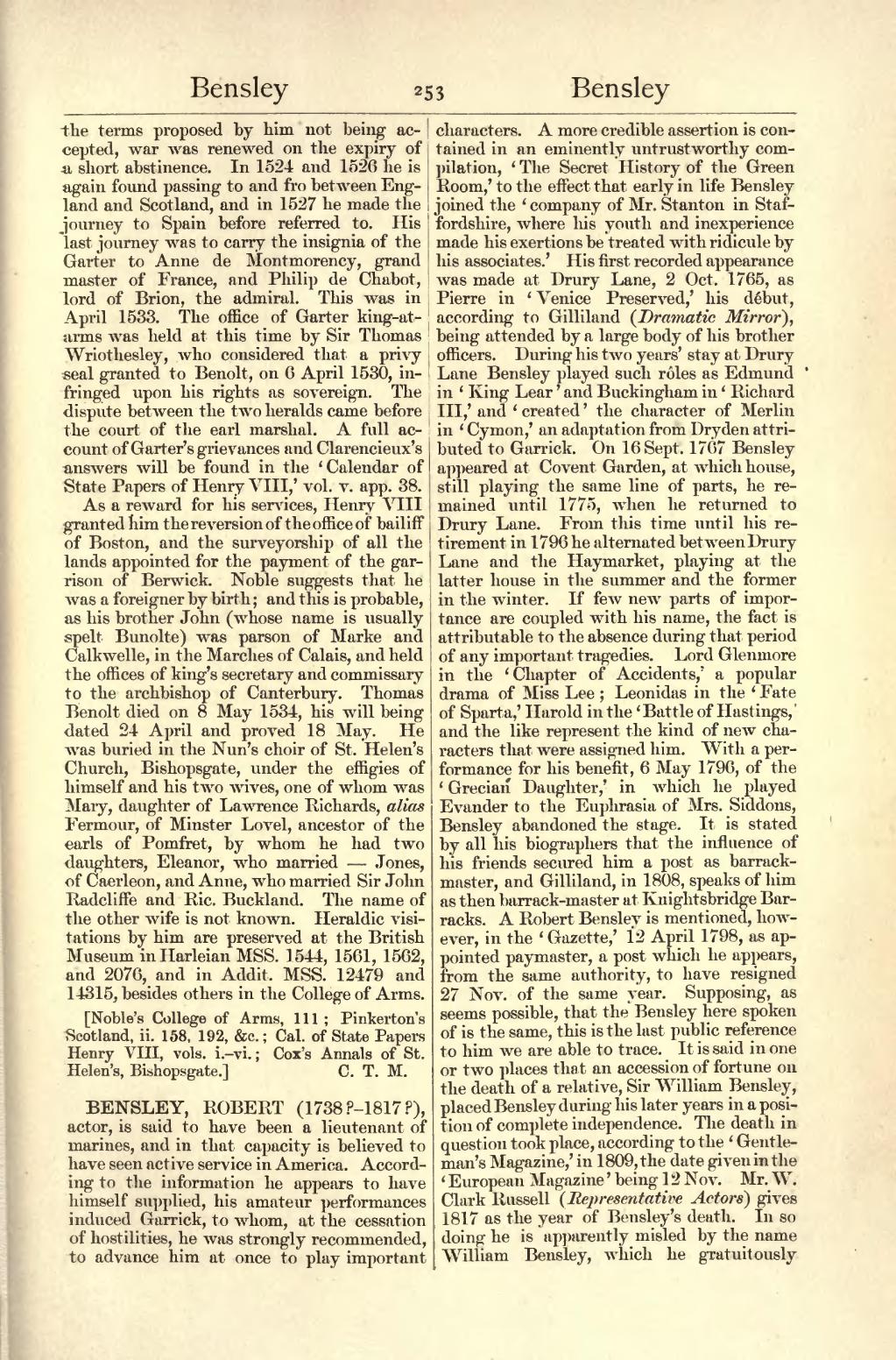the terms proposed by him not being accepted, war was renewed on the expiry of a short abstinence. In 1524 and 1526 he is
again found passing to and fro between England and Scotland, and in 1527 he made the journey to Spain before referred to. His last journey was to carry the insignia of the Garter to Anne de Montmorency, grand master of France, and Philip de Chabot, lord of Brion, the admiral. This was in
April 1533. The office of Garter king-at-arms was held at this time by Sir Thomas Wriothesley, who considered that a privy
seal granted to Benolt, on April 1530, infringed upon his rights as sovereign. The dispute between the two heralds came before the court of the earl marshal. A full account of Garter's grievances and Clarencieux's answers will be found in the 'Calendar of State Papers of Henry VIII,' vol. v. app. 38.
As a reward for his services, Henry VIII granted him the reversion of the office of bailiff of Boston, and the surveyorship of all the lands appointed for the payment of the garrison of Berwick. Noble suggests that he was a foreigner by birth; and this is probable, as his brother John (whose name is usually spelt Bunolte) was parson of Marke and Calkwelle, in the Marches of Calais, and held the offices of king's secretary and commissary to the archbishop of Canterbury. Thomas Benolt died on 8 May 1534, his will being dated 24 April and proved 18 May. He was buried in the Nun's choir of St. Helen's Church, Bishopsgate, under the effigies of himself and his two wives, one of whom was Mary, daughter of Lawrence Richards, alias Fermour, of Minster Lovel, ancestor of the earls of Pomfret, by whom he had two daughters, Eleanor, who married — Jones, of Caerleon, and Anne, who married Sir John Radcliffe and Ric. Buckland. The name of the other wife is not known. Heraldic visitations by him are preserved at the British Museum in Harleian MSS. 1544, 1561, 1562, and 2076, and in Addit. MSS. 12479 and 14315, besides others in the College of Arms.
[Noble's College of Arms, 111; Pinkerton's Scotland, ii. 158, 192, &c.; Cal. of State Papers Henry VIII, vols, i.-vi.; Cox's Annals of St. Helen's, Bishopsgate.]
BENSLEY, ROBERT (1738?–1817?), actor, is said to have been a lieutenant of marines, and in that capacity is believed to have seen active service in America. According to the information he appears to have himself supplied, his amateur performances induced Garrick, to whom, at the cessation of hostilities, he was strongly recommended, to advance him at once to play important characters. A more credible assertion is contained in an eminently untrustworthy compilation, 'The Secret History of the Green Room,' to the effect that early in life Bensley joined the 'company of Mr. Stanton in Staffordshire, where his youth and inexperience made his exertions be treated with ridicule by his associates.' His first recorded appearance was made at Drury Lane, 2 Oct. 1765, as Pierre in 'Venice Preserved,' his début, according to Gilliland (Dramatic Mirror), being attended by a large body of his brother officers. During his two years' stay at Drury Lane Bensley played such roles as Edmund in 'King Lear' and Buckingham in 'Richard III,' and 'created' the character of Merlin in 'Cymon,' an adaptation from Dryden attributed to Garrick. On 16 Sept. 1767 Bensley appeared at Covent Garden, at which house, still playing the same line of parts, he remained until 1775, when he returned to Drury Lane. From this time until his retirement in 1796 he alternated between Drury Lane and the Haymarket, playing at the latter house in the summer and the former in the winter. If few new parts of importance are coupled with his name, the fact is attributable to the absence during that period of any important tragedies. Lord Glenmore in the 'Chapter of Accidents,' a popular drama of Miss Lee; Leonidas in the 'Fate of Sparta,' Harold in the 'Battle of Hastings,' and the like represent the kind of new characters that were assigned him. With a performance for his benefit, 6 May 1796, of the 'Grecian Daughter,' in which he played Evander to the Euphrasia of Mrs. Siddons, Bensley abandoned the stage. It is stated by all his biographers that the influence of his friends secured him a post as barrack-master, and Gilliland, in 1808, speaks of him as then barrack-master at Knightsbridge Barracks. A Robert Bensley is mentioned, however, in the 'Gazette,' 12 April 1798, as appointed paymaster, a post which he appears, from the same authority, to have resigned 27 Nov. of the same year. Supposing, as seems possible, that the Bensley here spoken of is the same, this is the last public reference to him we are able to trace. It is said in one or two places that an accession of fortune on the death of a relative, Sir William Bensley, placed Bensley during his later years in a position of complete independence. The death in question took place, according to the 'Gentleman's Magazine,' in 1809, the date given in the 'European Magazine' being 12 Nov. Mr. W. Clark Russell (Representative Actors) gives 1817 as the year of Bensley's death. In so doing he is apparent misled by the name William Bensley, which he gratuitously
